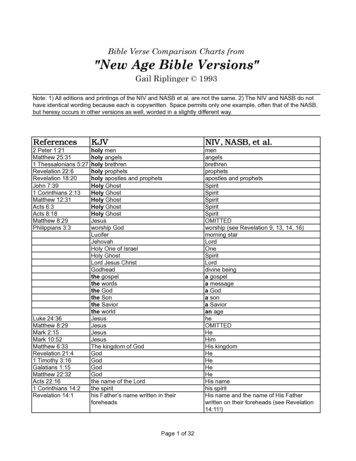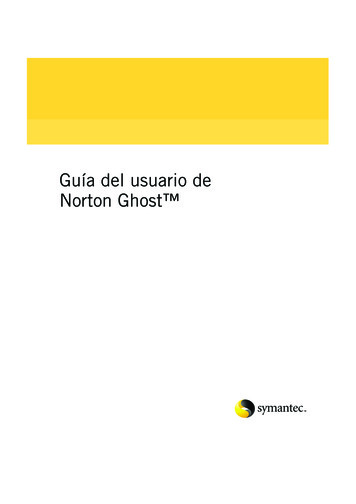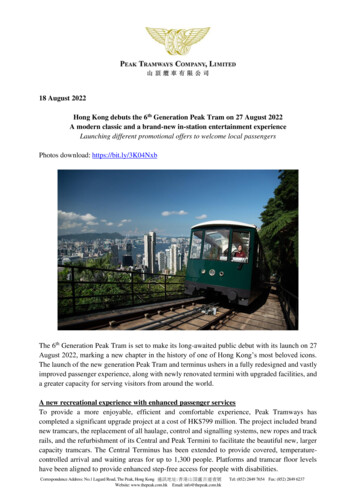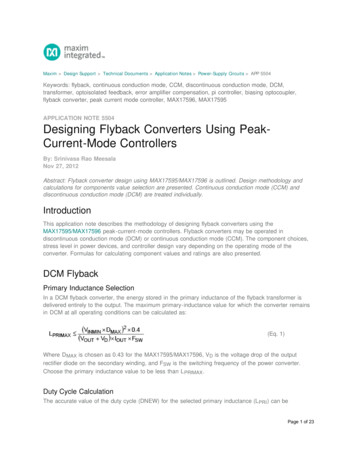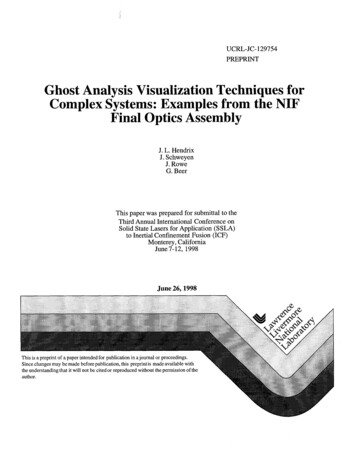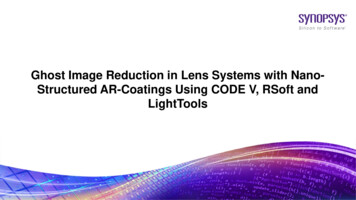
Transcription
doi.org/10.26434/chemrxiv.7993607.v1“Ghost Peak” Driven Structural Elucidation of a PhotocatalyticDegradation Product from BrexpiprazoleTao Zhuang, Fang Du, Jing Li, Haiqing Wang, Liang Chen, Bifeng Liu, Guisen ZhangSubmitted date: 15/04/2019 Posted date: 18/04/2019Licence: CC BY-NC-ND 4.0Citation information: Zhuang, Tao; Du, Fang; Li, Jing; Wang, Haiqing; Chen, Liang; Liu, Bifeng; et al. (2019):“Ghost Peak” Driven Structural Elucidation of a Photocatalytic Degradation Product from Brexpiprazole.ChemRxiv. Preprint.Brexpiprazole which marketed as Rexulti is a second-generation atypical antipsychotic. A seemingly randomand uncontrollable “ghost peak” that vary from below the detection limit to 0.2% was observed occasionallyduring the development of HPLC method for brexpiprazole drug substance. The “ghost peak” was finallycharacterized as a syn head-to-tail dimer of brexpiprazole by UV, IR, LC–MS/TOF, 1D and 2D NMR. It wasformed rapidly through photocatalytic [2 2] pericyclic reaction and can reach approximately 1.7% in fiveminutes once the analytes were exposed to sunlight at noon. By contrast, the occurrence of this “ghost peak”in brexpiprazole can be suppressed when the solutions were prepared and stored away from sunlight.File list (1)“Ghost peak” driven structural elucidation of a photocatalyt. (2.10 MiB)view on ChemRxivdownload file
“Ghost peak” driven structural elucidation of a photocatalytic degradationproduct from brexpiprazoleTao Zhuang a, b, Fang Du b, Jing Li b, Haiqing Wang b, Liang Chen b, Bifeng Liu a, b, Guisen Zhang aaSystems Biology Theme, Department of Biomedical Engineering, College of Life Science andTechnology, Huazhong University of Science and Technology, Wuhan 430074, ChinabNhwa Institute of Pharmaceutical Research, Jiangsu Nhwa Pharmaceutical Co., Ltd., 1 YunheRoad, Xuzhou, Jiangsu 221116, China*Correspondingauthor:Guisen ZhangSystems Biology Theme, Department of Biomedical Engineering, College of LifeScience and Technology, Huazhong University of Science and Technology, Wuhan430074, ChinaTel: 86-27-87792235, Fax: 86-27-87792170.E-mail: gszhang@mail.hust.edu.cn (G.S. Zhang)
Abstracts: Brexpiprazole which marketed as Rexulti is a second-generation atypicalantipsychotic. A seemingly random and uncontrollable “ghost peak” that vary frombelow the detection limit to 0.2% was observed occasionally during the developmentof HPLC method for brexpiprazole drug substance. The “ghost peak” was finallycharacterized as a syn head-to-tail dimer of brexpiprazole by UV, IR, LC–MS/TOF, 1Dand 2D NMR. It was formed rapidly through photocatalytic [2 2] pericyclic reactionand can reach approximately 1.7% in five minutes once the analytes were exposed tosunlight at noon. By contrast, the occurrence of this “ghost peak” in brexpiprazole canbe suppressed when the solutions were prepared and stored away from sunlight.Keywords: Brexpiprazole, Ghost peak, Photocatalytic [2 2] pericyclic reaction, LC–MS/TOF and NMRGraphical abstract
1. IntroductionBrexpiprazole (OPC-34712, Fig. 1.) is a novel serotonin-dopamine activitymodulator, which has been approved by FDA for the treatment of schizophrenia and asan adjunctive treatment for depression in 2015 [1, 2]. During the development of therelated substance HPLC method for brexpiprazole drug substance, a “ghost peak” wasintermittently observed at a relative retention time (RRT) of 1.60. HPLC results showedthat the amount of this “ghost peak” could vary from below the detection limit to 0.2%for the very same batch of the drug substance after initial investigation.Controllability is fundamental to all aspects of production and analysis in thehighly regulated pharmaceutical industry. High performance liquid chromatography(HPLC) enables the analysis of a mixture of analytes possessing a broad range ofpolarity and retention characteristics in a single run. However, HPLC methods cansometimes be plagued with seemingly random and unpredictable “ghost peaks”problems, particularly if the analyst does not appreciate the sensitive mechanismsinvolved [3]. The sources of these “ghost peaks” include sample degradation,instrumentation, solvents, glassware, and closure systems [4]. Recently, several groupsreported that analytical solution degradation caused by non-obvious reasons was one ofthe contributing factors for inducing such “ghost peaks” [5-8].Fig. 1. Chemical structures of brexpiprazole and the RRT 1.60 "ghost peak" withnumbering;
The behavior of the unknown peak presented at RRT 1.60 in brexpiprazole rendersitself another case of ghost peak occurrence. The uncontrollable occurrence of this“ghost peak” had a profound negative impact upon the robustness of the analyticalmethod. And as per the stringent regulatory requirements recommended by ICH, it ismandatory to identify and structurally characterize any unknown impurity formedduring production which is 0.1% [9]. Therefore, the aim of this study was to elucidatethe structure of the “ghost peak” and identify the root cause of its formation by LCPDA, prepared HPLC, LC-MS/TOF and NMR.2. Experimental2.1. Chemicals and reagentsBrexpiprazole (99.56% purity, Batch No. 20160302) drug substance used forinvestigation was synthesized in our laboratory. HPLC grade acetonitrile andammonium acetate were purchased from Thermo Fisher Scientific Inc. (Waltham,Massachusetts, USA). Acetic acid (AR grade) was purchased from Shanghai LingfengChemical Regent Co., Ltd. (Shanghai, China). Formic acid (HPLC grade) was obtainedfrom Anaqua Chemicals Supply (Wilmington, Delaware, USA). LC grade water wasprepared by filtrating through a Millipore Milli-Q-plus system (Merck Millipore,Massachusetts, USA). Dimethyl sulphoxide-d6 (for NMR) was purchased from SigmaAldrich Trading Co., Ltd. (Shanghai, China).2.2. High performance liquid chromatography (analytical)HPLC studies were carried out on LC-20AD liquid chromatograph (Shimadzu,Kyoto, Japan), which was equipped with a SPD-M20A prominence diode array detectorand degasser (DGU-20A3). The output signal was monitored and processed using LCSolution software. The chromatographic separation was achieved on a SHIMADZUShim-pack GIST C18 column (150 mm 4.6mm, 5 μm) using a gradient program ofammonium acetate buffer (0.01M, the pH value of solution was adjusted to 4.5 withacetic acid, mobile phase A) and ACN (mobile phase B) as mobile phase at a flow rateof 1.0 mL/min. The gradient program was set as follows: time/% of phase B: 0/20,
5/24.8, 10/32, 30/44, 35/44, 35.5/20, 42/20. The detector wavelength and injectionvolume was 235 nm and 5 μL, respectively. Chromatography was performed at 35 Cusing a flow rate of 1 mL/min. The analytes were dissolved in the mixture of mobilephase A and B in the ratio of 80:20 (v/v) under ultrasonic irradiation and diluted tovolume. Final samples were filtered through 0.45 μm membrane syringe filter beforeHPLC and LC-QTOF/MS/MS analysis. Sonication was undertaken with Branson 8510Sonicator (Branson Ultrasonics, Danbury, CT) equipped with a temperature controller2.3. Preparation and isolation of the RRT 1.60 impurity by preparative HPLCTo mimic the formation of the RRT 1.60 unknown peak, the brexpiprazole solutionin 80% mobile phase B (5mg/ml, 100 ml) was exposed to direct sunlight for about 6hours. The resulting solution was loaded onto a Shimadzu preparative HPLC instrumentfor isolation of the impurity. The Shimadzu LC-20A preparative HPLC system wasequipped with an automated fraction collector and UV detector. Data was collected andprocessed using LabSolutions chemstation software. A Welch Xtimate C18 column (250 30 mm, 5 μm) was employed for the separation of the targeted impurity. The mobilephase consists of a mixture of 0.1% formic acid in water and acetonitrile. The gradientprogram was set as follows: time/% of ACN: 0/35, 5/35, 15/55, 20/55, 20.5/35, 22/35.The flow rate was kept at 20 mL/min. Detection was carried out at 235 nm. Thefractions corresponding to the RRT 1.60 impurity were collected and concentrated byusing BC-R203 Rotary Evaporator (Shanghai Biochemical Equipment CO., LTD.)under high vacuum.2.4. Liquid chromatography-mass Spectrometry (LC-MS/MS)Mass spectrometry was carried out on an Agilent 6530 Accurate-Mass QuadrupoleTime-of-Flight (Q-TOF) LC/MS system equipped with an Agilent Jet Streamelectrospray source and controlled by Agilent MassHunter Acquisition software. Thetypical operating source conditions for MS scan of brexpiprazole and its impurity inpositive ESI mode were optimized as follows: capillary voltage, 4.0 KV; fragmentorvoltage, 100 V; drying gas (N2) flow rate, 7.0 L min-1; sheath gas (N2) flow rate, 11.0 L
min-1; drying gas temperature, 325 C; sheath gas temperature, 350 C; nebulizer gaspressure, 50 psi; and collision energy, 20 or 30 eV. Mass spectra were recorded in therange of m/z 100–1000 for MS and 80–1000 for MS/MS. For collision-induceddissociation experiments, keeping MS1 static, the precursor ion of interest was selectedusing the quadruple analyzer, and the product ions were analyzed using the TOFanalyzer. Ultrahigh pure nitrogen gas was used as collision gas. LC method for LCMS/MS studies was same with HPLC (section 2.2). However, to prevent condensationin the ionization source, the solvent flow into MS system was reduced from 1 ml/minto 500 μl/min by a diversion valve.2.5. Nuclear magnetic resonance spectroscopy (NMR)NMR spectra were recorded at 298 K on a Bruker AV 400 or Avance III 600 MHzspectrometer (Bruker BioSpin Corp., Billerica, MA, USA). All NMR spectra wereobtained using DMSO-d6 containing 0.05% (v/v) TMS as an internal reference. Protonand carbon chemical shifts were reported on δ scale in ppm, relative to TMS (δ 0.00ppm), DMSO-d6 (δ 39.50 ppm) as internal standards. Coupling constants (J) arereported in units of Hz. Two-dimensional NMR experiments were used to assign thechemical shifts of brexpiprazole and the RRT 1.60 impurity. Distortionlessenhancement by polarization transfer (DEPT), 1H-1H correlated spectroscopy (COSY),heteronuclear single-quantum correlation (HSQC), heteronuclear multiple-bondcorrelation (HMBC), and rotating frame nuclear overhauser and exchange spectroscopy(ROESY) were carried out to complete the assignment of individual peaks.2.6. FT-IR spectroscopyThe infrared spectroscopy data of brexpiprazole and the RRT 1.60 impurity wererecorded in the solid state as KBr dispersion using Nicolet avatar 330 FT-IRspectrophotometer (Thermo Nicolet Corporation, Madison, USA) over the range of4000-400 cm 1.2.7. Supplementary material
The supplementary material relating to this work contains FT-IR, 1D NMR (1H, 13Cand DEPT) and 2D NMR (1H-1H COSY, HSQC, HMBC and ROESY) spectra ofbrexpiprazole and the RRT 1.60 impurity.3. Results and discussion3.1. Random occurrence of “ghost peak” from brexpiprazole solutionDuring the development stage of the related substance HPLC method forbrexpiprazole, an unknown peak at RRT 1.60 was observed sporadically (Fig. 2).Although usually very small, the peak would sometimes appear at levels greater than0.1% when compared to the brexpiprazole peak, creating a significant quality concern.Due to its unpredictable nature of this unknown peak, it could be categorized as a “ghostpeak” [4]. To unveil the mask of this “ghost peak”, further investigations were initiated.Fig. 2. HPLC chromatogram at 235 nm of brexpiprazole solution(A) normal behaving chromatogram; (B) chromatogram with “ghost peak”.
At the beginning, ultrasonic irradiation in the preparing process of analytes waslisted as the prime suspect. Therefore, we investigated the effect of ultrasonicirradiation (30 min, 40 kHz, 30 C) on the degradation of brexpiprazole solution in 80%mobile phase B. But the HPLC results showed that there was no degradation productswere formed during this process.On the other hand, we found out by chance that the analytes prepared at noonshowed the highest levels of “ghost peak” and it can be avoided when this process waskept away from sunlight (Fig. 2). All of these led to the hypothesis that sunlight couldbe the root cause of the “ghost peak”.3.2. LC–PDA/UV–MS/MS analysisA brexpiprazole solution in 80% mobile phase B that displayed the RRT 1.60“ghost peak” was analyzed by LC-PDA-Qtof MS and MS/MS. The UV spectrum of the“ghost peak” was very similar to that of brexpiprazole except that the band at 300-350nm in brexpiprazole was nearly disappeared (Fig. 3). It suggested that the RRT 1.60species might be a degradation product of brexpiprazole and its formation wasaccompanied by some changes in the thianaphthene or quinolone chromophore. On theother hand, the full scan ( )-HR-ESI-MS spectrum of the RRT 1.60 species showed aFig. 3. Overlaid UV spectra of brexpiprazole and the RRT 1.60 “ghost peak” (extractedthrough LC-PDA spectrum).
Fig. 4. The ( )-HR-ESI-MS, MS/MS spectra of the RRT 1.60 “ghost peak”protonated molecular ion [M H] at m/z 867.3721, a potassiated ion [M K] at m/z905.3284, and a double-charged molecular ion [(M 2H]/2] at m/z 434.1903 (Fig. 4A ).The accurate m/z value of 867.3721 match a ion formula of [C50H55N6O4S2] (theoretical m/z: 867.3721), corresponding to the protonated ion of an “M M 2 M”type dimer of brexpiprazole [10]. The ESI-MS/MS spectrum of the RRT 1.60 species(Fig. 4B and 4C) displayed characteristic product ions at m/z 434.1894 (loss ofC25H27N3O2S from m/z 867.3721) and 273.1408 (loss of C9H7NO2 from m/z 434.1894).
The formation of m/z 434.1894 can be explained by loss of one molecular ofbrexpiprazole (C25H27N3O2S) from parent ion (m/z 867.3721) which also indicated thatDP1 was a dimer of brexpiprazole. When compared with the ( )-HR-ESI-MS, MS/MSspectra of brexpiprazole (Figs. S1), the presence of m/z 273.1408 further suggested that4-(4-(benzo[b] thiophen-4-yl)piperazin-1-yl)butoxy group was kept intact in DP. The( )-HR-ESI-MS, MS/MS spectra and proposed fragments of brexpiprazole andimpurity-I were shown in Fig. 5.Fig. 5. Plausible ESI-MS/MS fragmentation pathway of protonated brexpiprazole andthe RRT 1.60 “ghost peak”3.3. Preparation and isolation of the RRT 1.60 impurityTo facilitate further spectroscopic characterization and discuss possible formationmechanism of the RRT 1.60 species, a mechanism-based forced degradation outlinedin Section 2.3 was performed. The brexpiprazole solution in 80% mobile phase B(5mg/ml, 100 ml) was exposed to direct sunlight for about 6 hours to regenerate theRRT 1.60 unknown impurity. The HPLC results showed that the amounts of theunknown impurity was formed up to 28%. The UV and MS/MS spectra of the stressgenerated degradant matched well with those of the RRT 1.60 impurity in the originalsample solution, confirming that the “ghost peak” was indeed generated frombrexpiprazole via the catalysis of sunlight. The purified RRT 1.60 impurity obtained by
preparative HPLC (33.2 mg, HPLC purity: 98.07%, Section 2.3 for details) enable usto acquire 1D and 2D NMR data for further structure elucidation.3.4. Structure elucidation of the RRT 1.60 “ghost peak”The FT-IR spectrum of the RRT 1.60 “ghost peak” showed characteristicabsorptions at 2927, 2829 cm 1 (C-H, stretching), 1684 cm 1 (C O, stretching), 1623,1593, 1564, 1520 cm 1 (C C, stretching), 1369 cm 1 (C-N, stretching), 1263, 1170 cm 1(C-O, stretching) and 751 cm 1 ( C-H, out-of-plane bending) (Fig. S2). The absorptionband at 1653 cm 1 corresponding to amide (O C-NH) in brexpirazole (Fig. S3) was redshifted to 1684 cm 1 in this unknown impurity. Taken together with UV and HRMS/MS spectra (Section 3.2), FT-IR data further revealed that the RRT 1.60 “ghostpeak” was the dimerization product of brexpiprazole through quinolone fragment.Due to their similarities in the frames and functional groups, complete NMRassignments of brexpiprazole were essential for the identification of this unknownimpurity. The 1H and 13C NMR peak assignments and multiplicity for brexpirazole weretabulated in Table 1 based on 1D-NMR (1H, 13C, DEPT) and 2D-NMR (1H-1H COSY,HSQC, HMBC) data (Fig. S4-10).The 1H-NMR spectrum of the unknown impurity (Table 2, Fig. S11) was similarto that of brexpirazole (Table 1), with the most obvious differences consisting in: (a)the disappearance of two sets of aromatic signals in the range of δH 6-8 ppm; (b) thepresence of two additional sets of signals at δH 3.62 (m, H2-4, 4') and 3.41 (m, H2-3, 3')ppm; and (c) the singlet appearing at δH 11.59 (s, H1-1) ppm in brexpiprazolewas shifted upfield to δH 10.19 (s, H2-1, 1') ppm. The 13C NMR and DEPT spectra ofthe unknown impurity (Table 2, Fig. S12–13) displayed the same 19 sets of carbonsignals as brexpiprazole. It further suggested that the structure of the unknown impuritywere exactly symmetrical.The HSQC data (Table 2, Fig. S15) showed that the signals at δH 3.62 (m, H2-4,4') and 3.41 (m, H2-3, 3') were connected to the corresponding methine carbons at δC43.97 and 42.19, respectively. The COSY experiment also indicated these two protonscorrelated to each other (Fig. S14). The HMBC correlations (Table 2, Fig. S16) from
Table 1.NMR chemical shift assignments of brexpiprazole in DMSO-d6 (600 MHz)PositionδH (ppm), J (Hz)δC (ppm)DEPT111.59, 1H, s---C-3, 8, 102-162.21C--36.30, 1H, d (9.4)118.46CHH-4C-2, 9, 1047.81, 1H, d (9.4)139.98CHH-3C-2, 5, 8, 9, 1057.56, 1H, d (9.3)129.22CHH-6C-4, 6, 7, 8, 9, 1066.81, 1H, m110.83CHH-5C-7, 8, 107-160.43C--86.82, 1H, br s98.59CH-C-6, 9, 109-140.65C--10-113.24C--114.06, 2H, t (6.4)67.61CH2H-12C-7, 12, 13121.82, 2H, tt (6.6, 6.6)26.55CH2H-11, 13C-11, 13, 14131.64, 2H, tt (7.2, 7.2)22.69CH2H-12, 14C-11, 12, 14142.45, 2H, t (7.2)57.35CH2H-13C-12, 13, 15, 1815,182.62, 4H, br. s52.97CH2H-16, 17,-16,173.07, 4H, br. s51.72CH2H-15, 18,C- 15, 18, 1919-148.23C--20-133.36C--21-140.38C--227.62, 1H, d (8.0)116.61CHH-23C-19, 20, 23, 24237.28, 1H, dd (7.8, 7.8)125.07CHH-22, 24C-19, 20, 21, 22, 24246.88, 1H, dd (7.7, 0.8)112.00CHH-23C-19, 20, 21, 22, 25257.40, 1H, d (5.5)121.87CHH-26C-19, 20, 21, 26267.70, 1H, d (5.5)125.79CHH-25C-19, 20, 21, 22, 251H-1HCOSYHMBCthe amide proton signals at δH 10.19 (s, H2-1, 1') to δC 42.19 (C-3, 3'), and from thearomatic proton signals at δH 6.72 (d, J 8.2 Hz, H2-5, 5') to δC 43.97 (C-4, 4'), alongwith the aforementioned 1H-NMR, 1H-1H COSY and HSQC data, suggested that theprotons corresponding to the α, β-unsaturated double bond of the parent quinolone werereplaced with two methines and a symmetrical cyclobutane unit was formed betweentwo molecules of brexpiprazole.
It has been reported that substituted coumarin or 2-quinolone derivates can giverise to four isomeric dimers (syn head-to-head, anti head-to-head, anti head-to-tail, andsyn head-to-tail) during photodimerization [13-14]. The configuration of this “ghostpeak” was determined as syn head-to-tail by the NOE correlations of H-1/H-6' (or H1'/H-6) and H-5/H-8' (or H-5'/H-8) in the ROESY data (Fig. S17-18).Table 2. NMR chemical shift assignments of the RRT 1.60 impurity in DMSO-d6 (400MHz)PositionδH (ppm), J (Hz)δC (ppm)DEPT1, 1'10.19, 2H, s---C-2, 3, 8, 9, 102, 2'-169.38C--3, 3'3.41, 2H, m42.19CHH-4, 4'C-2, 4, 9, 104, 4'3.62, 2H, m43.97CHH-3, 3'C-2, 3, 5, 9, 105, 5'6.72, 2H, d (8.2)127.93CHH-6, 6'C-4, 6, 7, 96, 6'6.48, 2H, dd (8.1, 2.5)108.21CHH-5, 5'C-7, 8, 9, 107, 7'-158.42C--8, 8'6.51, 2H, d (2.5)101.99CH-'C-6, 7, 9, 109, 9'-138.60C--10, 10'-114.38C--11, 11'3.94, 4H, t (6.3)67.31CH2H-12, 12'C-7, 12, 1312, 12'1.75, 4H, m26.60CH2H-11, 11', 13, 13'C-11, 13, 1413, 13'1.62, 4H, m22.67CH2H-12, 12', 14, 14'C-11, 12, 1414, 14'2.45, 4H, t (7.1)57.31CH2H-13, 13'C-11, 12, 1315, 15', 18, 18'2.63, 8H, s52.93CH2H-16, 16', 17, 17'-16, 16', 17, 17'3.07, 8H, s51.66CH2H-15, 15', 18, 18'C-15, 1819, 19'-148.21C--20, 20'-133.36C--21, 21'-140.39C--22, 22'7.60, 2H, d (8.0)116.60CHH-23, 23'C-19, 20, 2423, 23'7.26, 2H, tt (7.8, 7.8)125.04CHH-22, 22', 24, 24'C-19, 20, 21, 2424, 24'6.89, 2H, d (7.6)112.00CHH-23, 23'C-19, 20, 21, 22, 2525, 25'7.40, 2H, d (5.5)121.85CHH-26, 26'C-19, 20, 21, 22, 2626, 26'7.68, 2H, d (5.5)125.76CHH-25, 25'C-20, 21, 22, 251H-1HCOSYHMBC
3.5. Proposed formation mechanism and prevention of the RRT 1.60 “ghost peak”Based on the structure we characterized in section 3.4 (Fig. 1), the formationmechanism of RRT 1.60 “ghost peak” can be rationalized by photocatalytic [2 2]cycloadditions reaction. The [2 2] photocyclization begins with photoexcitation of theα, β-unsaturated ketone in one molecular of brexpiprazole to a singlet excited state (Fig.6). The singlet state is very short lived, and then transit to the triplet state throughintersystem crossing. At this point, the enone forms an exciplex with the ground-statealkene which from another molecular of brexpiprazole, eventually forming a tripletdiradical intermediate. And the RRT 1.60 “ghost peak” was formed once spin inversionfrom the triplet diradical to the singlet diradical occurred [11, 12]. The hypothesis wasfurther corroborated by the fact that the amount of the unknown impurity can reach upto 1.7% after the sample solution was exposed to direct sunlight for about five minutesat noon (Fig. S19). According to the proposed formation mechanism of RRT 1.60“ghost peak”, it can be avoided by keep sample solution away from sunlight (Fig. S19).Fig. 6. Proposed formation mechanism of the RRT 1.60 “ghost peak”
4. ConclusionGhost peaks are often observed unexpectedly and intermittently in HPLCchromatograms, especially in the gradient mode. And these “ghost peaks” can pose achallenge to analytical scientists because they may arise from some non-obviousreasons. In this study, a “ghost peak” observed in HPLC chromatograms was isolatedand characterized as a syn head-to-tail dimer of brexpiprazole by UV, IR, LC–MS/TOF,1D and 2D NMR. Based on the structure we proposed, it was identified that the rootcause for the undesirable occurrence of the RRT 1.60 “ghost peak” in brexpiprazolewas due to photocatalytic [2 2] pericyclic reaction, which can be prevented by keepinganalytes away from sunlight. We hope the results from this investigation may facilitateghost peak investigations in other pharmaceutical analytical laboratories.
References[1] A. Yee, Brexpiprazole for the treatment of schizophrenia, Expert Rev. Neurother. 16 (2016) 109–122.[2] K.P. Garnock-Jones, Brexpiprazole: A Review in Schizophrenia, CNS Drugs 30 (2016) 335–342.[3] S. Williams, Ghost peaks in reversed-phase gradient HPLC: a review and update, J. Chromatogr.A 1052 (2004) 1–11.[4] S. Redkar, S. Sadikin, R. Inloes, D.D. Zhang, Ghost peak investigation in a reversed-phasegradient LC system, LCGC N. Am. 29 (5) (2011) 394–400.[5] S.W. Baertschi, B.A. Olsen, T.J. Wozniak, N. Toltl, C. O’Shea, P.J. Jansen, Formation of copper(I)from trace levels of copper(II) as an artifactual impurity in the HPLC analysis of olanzapine, J.Pharm. Biomed. Anal. 125 (2016) 186–193.[6] R. Arvary, I. Mangion, The importance of vial composition in HPLC analysis: An unusual caseof phosphorous pseudorotation, J. Pharm. Biomed. Anal. 134 (2017) 237–242.[7] J.Y. Jin, Z.Y. Wang, J.S. Lin, W.Q. Zhu, C.Z. Gu, M. Li, Ghost peaks of ezetimibe: solutiondegradation products of ezetimibe in acetonitrile induced by alkaline impurities from glassHPLC vials, J. Pharm. Biomed. Anal. 140 (2017) 281–286.[8] J.S. Lin, Z. Lin, D. Li, M.X. Feng, Q. Yang, W.P. Hu, Y. Han, W.Q. Zhu, M. Li, L.S. Yu, “Ghostpeak” of clofazimine: A solution degradation product of clofazimine via nucleophilicsubstitution by nitrite leaching from certain glass HPLC vials, J. Pharm. Biomed. Anal. 150(2018) 183–190.[9] International Conference on Harmonization of Technical Requirements for Registration ofPharmaceuticals for Human Use, ICH Q3A (R2), Impurities in New Drug substances, 2006, 1–15.[10] M. Li, Organic Chemistry of Drug Degradation, Section 4. 7 Dimerization/Oligomerization,Royal Society of Chemistry, London, UK, 2012, pp. 139–144.[11] R.O. Loutfy, P.De Mayo, Primary Bond Formation in the Addition of Cyclopentenone toChloroethylenes, Can. J. Chem. 50 (1972): 3465–3471.[12] S. Poplata, A. Tröster, Y.Q. Zou, T. Bach, Recent advances in the synthesis of cyclobutanes byolefin [2 2] photocycloaddition reactions, Chem. Rev. 116 (2016): 9748–9815.
[13] F.D. Lewis, G.D. Reddy, J.E. Elbert, B.E. Tillberg, J.A. Meltzer, M. Kojima, Spectroscopy andPhotochemistry of 2-Quinolonesand Their Lewis Acid Complexes, J. Org. Chem. 56 (1991):5311-5318.[14] X.L. Yu, D. Scheller, O. Rademacher, T. Wolff, Selectivity in the Photodimerization of 6Alkylcoumarins, J. Org. Chem. 68 (2003): 7386-7399.
“Ghost peak” driven structural elucidation of a photocatalytic degradationproduct from brexpiprazoleTao Zhuang a, b, Fang Du b, Jing Li b, Haiqing Wang b, Liang Chen b, Bifeng Liu a, b, Guisen Zhang aaSystems Biology Theme, Department of Biomedical Engineering, College of Life Science andTechnology, Huazhong University of Science and Technology, Wuhan 430074, ChinabNhwa Institute of Pharmaceutical Research, Jiangsu Nhwa Pharmaceutical Co., Ltd., 1 YunheRoad, Xuzhou, Jiangsu 221116, ChinaSupplementary material*Correspondingauthor:Guisen ZhangSystems Biology Theme, Department of Biomedical Engineering, College of LifeScience and Technology, Huazhong University of Science and Technology, Wuhan430074, ChinaTel: 86-27-87792235, Fax: 86-27-87792170.E-mail: gszhang@mail.hust.edu.cn (G.S. Zhang)
Contents:Fig. S1 The ( )-HR-ESI-MS, MS/MS spectra of brexpirazoleFig. S2 FT-IR spectrum of the RRT 1.60 impurity (KBr)Fig. S3 FT-IR spectrum of brexpirazole (KBr)Fig. S4 1H NMR spectrum of brexpirazole (600 MHz, DMSO-d6)Fig. S5 13C NMR spectrum of brexpirazole (150 MHz, DMSO-d6)Fig. S6 DEPT 90 spectrum of brexpirazole (150 MHz, DMSO-d6)Fig. S7 DEPT 135 spectrum of brexpirazole (150 MHz, DMSO-d6)Fig. S8 1H-1H COSY spectrum of brexpirazole (600 MHz, DMSO-d6)Fig. S9 HSQC spectrum of brexpirazole (600 MHz, DMSO-d6)Fig. S10 HMBC spectrum of brexpirazole (600 MHz, DMSO-d6)Fig. S11 1H NMR spectrum of the RRT 1.60 impurity (400 MHz, DMSO-d6)Fig. S12 13C NMR spectrum of the RRT 1.60 impurity (100 MHz, DMSO-d6)Fig. S13 DEPT 135 spectrum of the RRT 1.60 impurity (100 MHz, DMSO-d6)Fig. S14 1H-1H COSY spectrum of the RRT 1.60 impurity (400 MHz, DMSO-d6)Fig. S15 HSQC spectrum of the RRT 1.60 impurity (400 MHz, DMSO-d6)Fig. S16 HMBC spectrum of the RRT 1.60 impurity (400 MHz, DMSO-d6)Fig. S17 ROSEY spectrum of the RRT 1.60 impurity (600 MHz, DMSO-d6)Fig. S18 Key NOE correlations of the RRT 1.60 impurityFig. S19 HPLC chromatogram at 235 nm of brexpiprazole solution
Fig. S1. The ( )-HR-ESI-MS, MS/MS spectra of brexpirazole
Fig. S2. FT-IR spectrum of the RRT 1.60 impurity (KBr)Fig. S3. FT-IR spectrum of brexpirazole (KBr)
Fig. S4. 1H NMR spectrum of brexpirazole (600 MHz, DMSO-d6)Fig. S5. 13C NMR spectrum of brexpirazole (150 MHz, DMSO-d6)
Fig. S6. DEPT 90 spectrum of brexpirazole (150 MHz, DMSO-d6)Fig. S7. DEPT 135 spectrum of brexpirazole (150 MHz, DMSO-d6)
Fig. S8. 1H-1H COSY spectrum of brexpirazole (600 MHz, DMSO-d6)Fig. S9. HSQC spectrum of brexpirazole (600 MHz, DMSO-d6)
Fig. S10. HMBC spectrum of brexpirazole (600 MHz, DMSO-d6)Fig. S11. 1H NMR spectrum of the RRT 1.60 impurity (400 MHz, DMSO-d6)
Fig. S12. 13C NMR spectrum of the RRT 1.60 impurity (100 MHz, DMSO-d6)Fig. S13. DEPT 135 spectrum of the RRT 1.60 impurity (100 MHz, DMSO-d6)
Fig. S14. 1H-1H COSY spectrum of the RRT 1.60 impurity (400 MHz, DMSO-d6)Fig. S15. HSQC spectrum of the RRT 1.60 impurity (400 MHz, DMSO-d6)
Fig. S16. HMBC spectrum of the RRT 1.60 impurity (400 MHz, DMSO-d6)Fig. S17. ROSEY spectrum of the RRT 1.60 impurity (600 MHz, DMSO-d6)
Fig. S18. Key NOE correlations of the RRT 1.60 impurity
Fig. S19. HPLC chromatogram at 235 nm of brexpiprazole solution (A) kept awayfrom sunlight; (B) exposed to direct sunlight for about five minutes at noon.
“Ghost peak” driven structural elucidation of a photocatalyt. (2.10 MiB)view on ChemRxivdownload file
prepared by filtrating through a Millipore Milli-Q-plus system (Merck Millipore, Massachusetts, USA). Dimethyl sulphoxide-d 6 (for NMR) was purchased from Sigma-Aldrich Trading Co., Ltd. (Shanghai, China). 2.2. High performance liquid chromatography (analytical) HPLC studies were carried out on LC-20AD liquid chromatograph (Shimadzu,
